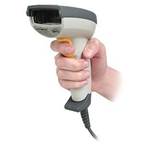Barcodes (条形码) aren’t given much thought by the majority of consumers, but these codes were fairly recently applied in a working fashion in 1970.
A small food store owner decided one day that keeping records of the inventory (存货) of his stock and the associated prices were an extremely laborious process, and so, in 1948, he contacted the The Drexel Institute of Technology in a bid to work towards a solution. Bernard Sliver rose to the challenge and set out to study the problem, and began working on a solution involving an automatic way of keeping track of items that had been sold. Silver and a group of students from the institute realized their answer in the form of ultraviolet light (紫外线), ink and a scanner.

The system worked initially, but possessed some negatives. It was incredibly costly to carry out on a large scale and the system was also unstable. If the invention was to become commonplace (寻常的事) in grocery stores, these two problems had to be solved.
The patent (专利)for the bar code system was filed by Sliver and one of his students, Woodland. The patent was not granted immediately; in fact it took three years for the patent agency to grand their invention patent for the barcode, occurring on 7
th October, 1952.
Despite the patent being issued, the system was still not welcomed by the majority of store owners. It was not until 1966 that the system began moving its way into more and more grocery stores. This system was soon criticised, as there was no central mechanism for controlling uniformly coded items. In 1970, Logicorn developed the Universal Grocery Products Identification code (UGOIC), soon shortened to Universal Identification Number (UPC). It was Marsh’s superstore, in Troy, which was the very first store to install this complex barcode reading system, and its popularity has soared (升温) ever since, and is obviously now commonplace in all types of stores worldwide.
小题1:What is stressed in the second paragraph?
| A.The heavy work of store owners. |
| B.The function of ultraviolet light, ink and a scanner. |
| C.The origination of barcodes |
| D.Bernard Silver’s education background. |
小题2:Which of the following was NOT a drawback of Silver’s system?
| A.It was expensive to be applied on a large scale. |
| B.It was a laborious process. |
| C.The system was not stable. |
| D.It lacked a central mechanism. |
小题3:What is the purpose of the text?
| A.To tell people that failure is the mother of success. |
| B.To praise scientists’ efforts in making people’s lives easier. |
| C.To describe shop owners’ opinions of barcodes. |
| D.To provide information about the development of barcodes. |